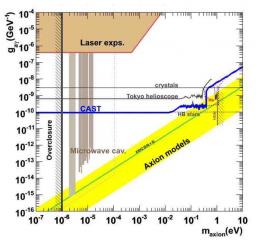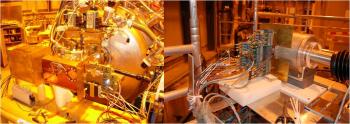The Nobel Prize for Physics 2008 rewarded Makoto Kobayashi and Toshihide Maskawa for having realised that the weak interaction does not affect particles and antiparticles in the same way1. In this theory, it was expected that the strong interaction would exhibit the same type of asymmetry between quarks and antiquarks.
However the asymmetry is not there! A problem! To explain this anomaly of the strong interaction, theoreticians have postulated the existence of a new particle known as the "axion", named after a detergent because it will help to clean up the problem. Expected to be both neutral and light, this particle will be analogous to a photon, with which it could be coupled. On the other hand it will only interact slightly with matter, so slightly that, to date, it has never been observed.
CAST2 is an experiment designed to detect this hypothetical particle which may be produced abundantly by the sun. The collaboration recently published their results ("Journal of Cosmology and Astroparticle Physics") which have enabled the limits of the predicted mass of the axion to be reduced.
The search for axions continues, thanks to improvement in the performance of the CAST Micromegas detectors, enabling the level of noise to be reduced to an extremely low level, in the low energy regime between 1 and 10 keV, and so to further reduce the lower limit for detection of these hypothetical particles.
Axions are particles which were introduced by theoreticians to explain the apparent symmetry between matter and antimatter in the strong interaction. These axions, neutral and of very low mass, are also candidates to make up the dark matter in our universe. Theoretical models and astrophysical observations limit the mass of the axion to being in the range between several µeV/c2 and several eV/c2.
The absence of observation of axions in the CAST experiment has enabled an experimental upper limit to be established for the axion-photon coupling constant, for masses less than 0.4 eV/c2 (figure 1). For the first time this limit has reached the yellow band favoured by the theoretical models.

Figure 1: Limits of the photon-axion coupling constant as a function of the axion mass. The yellow band shows the region favoured by axion models. The blue line represents the lower limit of the region excluded by the data obtained in the first phase of the CAST experiment and the data with 4He, exceeding the limit obtained by stellar constraints. The regions excluded by laser experiments are also shown as well as the limits obtained by dark matter detector experiments and the Tokyo Helioscope. At low mass, 10-5 eV, these microwave cavity experiments are the most sensitive.
Axions, if they exist, couple weakly to light. Hence they may be produced in the core of the sun by thermal photons which diffuse over the protons and electrons. The CAST experiment, using an intense magnetic field (9 T) produced by the prototype of one of the LHC superconducting magnets, reconverts axions back into photons. The magnet is mounted on a rail in order to observe the sun as it rises and sets, hence the name "helioscope for axions" (figure 2). An axion signal should manifest itself during an observation of the sun in the form of an excess of X photons with a mean energy of 4 keV. X-ray sensitive detectors have been installed at the end of each of the vacuum tubes of the magnet: "sunrise" and "sunset" detectors. To observe the signal, drowned by the background noise from cosmic radiation and natural radioactivity, the detectors must be designed with very low radioactive materials and must be a capable of having good background rejection in order to distinguish events resulting from axion conversion (0.03 events/hr are expected over a surface of 14 cm2).
In the first phase, during which the magnet was operated under vacuum, the data collected (from 2003 to 2004) enabled the experimental upper limit for the mass to be lowered by a factor of 5, to 0.02 eV/c2. This limit corroborates for the first time, in an experimental way, the limits given by astrophysical arguments derived from stellar constraints. During this phase, only one conventional Micromegas detector, with a two dimensional readout plane, was installed ("sunrise" location) side by side with a CCD detector coupled with a focusing telescope. On the other side of the magnet, the "sunset" side, a conventional TPC covered the two vacuum tubes of the magnet. This first Micromegas detector, manufactured from low radioactivity materials, has shown a great capacity for separating events coming from X-Ray photons from the background noise, and this without shielding.
In the second phase of the experiment, the magnet has been modified to operate in gas (4He and 3He) at low pressure. Hence the sensitivity of the experiment has been extended to higher axion masses by varying the pressure of the gas in a controlled way. At the end of 2005 and in 2006, solar data were collected at 160 different pressures of 4He, in steps of 0.08 mbar, up to pressures of 13.4 mbar. The analysis of this data was the subject of the publication JCAP 02 (2009) 008 (figure 1).
The good performance of the first Micromega detector installed on CAST convinced the rest of the collaboration of replacing the aging TPC with two new Micromegas detectors. Three new detectors have been designed with the new Micromegas technology, called microbulk, which is intrinsically constructed from very low radioactivity materials. At the same time, optimised shielding has been constructed by the University of Zaragoza, consisting of layers of copper, cadmium, lead, polyethylene, and a nitrogen flow.
Thanks to these new improvements, the detectors have achieved exceptional performance with a reduction in background noise of around a factor of 100. The extent of this rejection of background noise, composed principally of cosmic rays and ambient radioactivity, enabled observation of an effect which has only previously been seen in subterranean experiments. As demonstrated in figure 4, when an inert gas, N2, circulates around the detector (between the levels of screening) the background noise drops continuously to reach its lowest level after 10 days. This phenomenon is attributed to the progressive evacuation of radon, flushed out by the flow of gas. These exceptional results open a new window to discover axions and for the continuation of CAST beyond 2010. Such performance has led to reconsideration of the first phase of the experiments to improve the current limits (ma < 0.02 eV/c2) by around a factor of 2 with just one year of data collection.

Figure 3: Left: view of the installation of the two Micromegas "sunset" detectors, in their copper shielding screening. Right: the Micromegas "sunrise" detector in the cylindrical copper and lead shielding screening. Several of the polyethylene layers which completely surround the detector are also visible.
CAST Coll., Probing eV-scale axions with CAST, JCAP 02 (2009) 008.
CAST Coll., An improved limit on the axion-photon coupling from the CAST experiment JCAP 0704:010, 2007.
CAST Coll., First results from the CERN Axion Solar Telescope, Phys.Rev.Lett.94:121301, 2005.
1) A phenomenon known as CP symmetry violation
2) The CERN Axion Solar Telescope
• Structure and evolution of the Universe › Dark Universe
• Institute of Research into the Fundamental Laws of the Universe • The Electronics, Detectors and Computing Division
